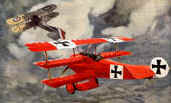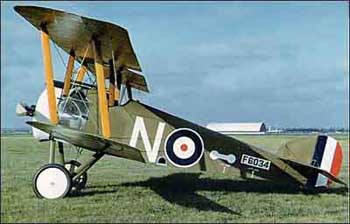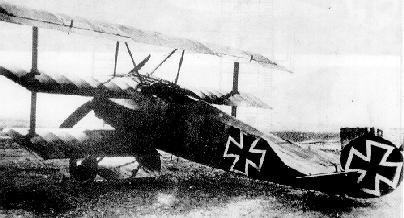Famous Planes of World War One
Fokker DR.I Triplane and The Sopwith Camel
Fokker DR.I Triplane
Modeled after the Sopwith Triplane the Fokker Dr.1
was made known by association with it's most famous
pilot, Manfred Von Richthofen (The Red Baron).
The Dr stood for Dreidecker or 3 wings.
While not as fast as contemporary biplanes, the Dreidecker
could easily outclimb any opponent. Despite it's 3 wings,
it was relatively small, lightweight and highly
maneuverable. It offered good upward visibility and
lacked the traditional bracing wires that could be shot
away during combat.
It could fly at a maximum altitude of 14,000 ft. Like
most planes in World War One, the Fokker Dr.1 had a rotary
engine. The propeller was bolted directly onto the engine
and the engine and the propeller would rotate together.
The Fokker Dr.1 had one open pit, which could hold one
pilot. The Fokker Dr.1 had two machine guns with an
interceptor gear that was designed to fire bullets
through the propeller arc without hitting the blades.
August 1917
Number Built: 320
Engine(s): Oberursel UR.II, 9 cylinder reciprocating, 110 hp
Le Rhône, 9 cylinder rotary, 110 hp
Wing Span: 23 ft 7 3/8 in
Length: 18 ft 11 1/8 in
Height: 9 ft 8 in
Empty Weight: 893 lb
Gross Weight: 1,289.2 lb;
Max Speed: 103.12 mph @ 13,120 ft
Ceiling: 20,013 ft [6100 m]
Endurance: 1.5 hours
Crew: 1
Armament: 2 Spandau 7.92 mm light machine guns

Sopwith Camel
The Sopwith Camel was made one of the most famous
planes in World War One by having been credited
with being responsible for dowing more German aircraft
than any other plane design of the Allies. (1,294
enemy aircraft, including balloons and airships)
The Sopwith company rolled out the first Camel in December
1916. Much of its design features were borrowed from earlier
aircraft like the Tabloid, Pup and Triplane,
The plane had twin Vickers machine guns were mounted
side by side in front of the pit (a first for British
fighters and a design feature that became standard).
The pilot, engine, armament and controls were all crammed
into a seven foot space at the front of the airplane.
This helped give the plane its phenomenal performance,
but it also made the plane very tricky to fly.
The plane's wood and fabric construction and lack of
protection for the fuel tank made the Camel very
susceptible to fire.
Despite it's reputation for downing enemy aircraft, it
also developed a reputation for killing inexperienced
pilots. Because of it's high engine torque on takeoff,
it had a tendency to do a ground loop on takeoff
with subsequent crash. During World War I, 413 pilots
died in combat and 385 pilots died from non-combat
related causes while flying the Sopwith Camel.
Captain Roy Brown was flying a Sopwith Camel when he was
credited with shooting down the Red Baron,
Manfred von Ricthofen, in 1918. Roy Brown's plane was built
by Clayton and Shuttleworth Ltd at the Titanic Works, Lincoln.

Sopwith Aviation Company
May 1917
Number Built: 5,734
Engine(s): Bentley BR.1, 150 hp
Reciprocating Le Rhône Rotary x 1, 110 hp
Clerget 9B, 9 cylinder, air cooled rotary, 130 hp
Clerget 9Bf, 9 cylinder, air cooled rotary, 140 hp
Wing Span: 28 ft
Length: 18 ft 8 in
Height: 8 ft 6 in
Empty Weight: 889 lb
Gross Weight: 1,422 lb
Max Speed: 118 mph
Ceiling: 19,000 ft
Endurance: 2.5 hours
Crew: 1
Armament: 2 Vickers .303 machine guns (F.1)
1 Vickers .303 and 1 Lewis .303 machine guns
or 2 Lewis .303 machine guns (2F.1)
Charlie Brown and Snoopy
More Famous People
For Really Cool Pet Related Gift Items
Our Pet Gift Shop Online Here
Stuffed Animals
Dog Breed Gifts
Gift Items for Cats
Free Dog Care Tips
Free Cat Care Tips
Free Horse Care Tips
Home
Copyright ©
Choose To Prosper


